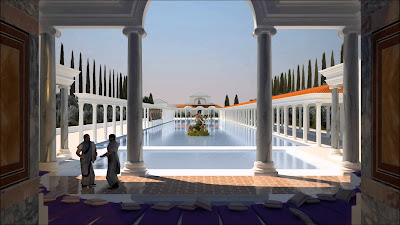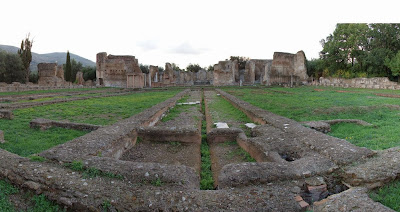NOW you can follow in the footsteps of Antinous and stroll through Hadrian's Villa ... as a digital avatar.
Bernie Frischer, a digital archaeologist at Indiana University and one of the first academics to use 3-D computer modeling to reconstruct cultural heritage sites, spent five years leading the development of the extraordinary 3-D VIRTUAL HADRIAN'S VILLA.
The virtual simulation interprets the entire 250 acres and the more than 30 buildings of the 2nd-Century site.
The image above shows the digital 3-D virtual recreation of the Piazza D'Oro and adjacent gardens at Hadrian's Villa. The other image shows the ruins which visitors to the site see today.
Using a live 3-D multi-user online learning environment, visitors can interactively explore the entire villa complex.
A RELATED WEBSITE documents the state of the site today and gives the scholarly background needed to understand the virtual simulation.
The project combines information garnered from scholarly studies of how the villa was used with the virtual world gaming platform Unity 3D.
Frischer and the Virtual World Heritage Laboratory, which he directs at IU's School of Informatics and Computing, worked with the Institute for Digital Intermedia Arts at Ball State University to offer visitors the opportunity to take on the roles of historically accurate avatars.
That means you can slip into the avatar identity of members of the Imperial Court and Roman senators as well as soldiers and slaves.
"The website makes it possible to study the state of the ruins today, including many sites on private land or in parts of the archaeological park closed to the public," Frischer said.
"The simulation shows how the site looked during the reign of Hadrian," he added. "It can be freely explored and used to support teaching and research."
Non-playing characters also populate various places in the virtual villa, carrying out daily activities that would have occurred during the final years of Hadrian’s reign from 117 to 138 A.D.
A visit to the website might include eavesdropping on an imperial audience, participating in a feast, bathing or worshipping.
"A user can select from a variety of avatars representing class, gender and ethnicity, including courtiers, senators, scholars, freemen, soldiers and slaves," Frischer said.
"This avatar system was based on scholarly studies of the circulation and flow throughout the villa," he added. "The goal was to make everything evidence-based, from the avatars' costumes to their gestures."
For an example of the avatar experience, join Frischer on an eight-minute YouTube tour of the virtual villa, with Frischer playing the avatar's role of Hadrian:

























